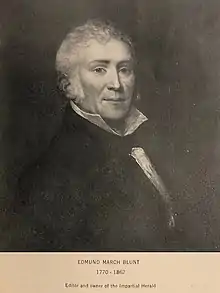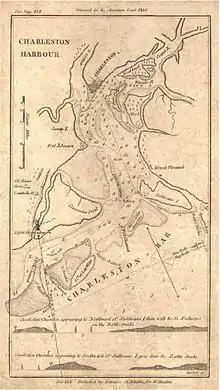Edmund March Blunt
Edmund March Blunt (June 20, 1770 – January 4, 1862) was an American navigator, author, and publisher of nautical magazines.[3] He established a nautical book and chart publishing firm that became the largest publishing firm in early 19th century.[4] In 1796, he published American Coastal Pilot, which described every port of the United States. Blunt created a map in 1796 of what is now the Federated States of Micronesia.[5]
Edmund March Blunt | |
|---|---|
 Edmund March Blunt (1770-1862). | |
| Born | June 20, 1770[1] Portsmouth, New Hampshire, United States[1] |
| Died | January 4, 1862 (aged 91) Sing Sing, New York, United States |
| Occupation | Navigator, publisher, writer |
| Spouse(s) | Sarah Ross[2] |

Personal life
Blunt was born in Portsmouth, New Hampshire,[1] and lived in Sing Sing, New York.[1][6] He had four sons: Nathaniel B., Edmund, George and Joseph.[1] Edmund Blunt was a hydrographer.[1] Mount Blunt in Antarctica is named for him. [7]
Nautical publisher
Blunt published the Impartial Herald, under the firm name of Blunt and Robinson, which was established on May 18, 1793. The firm was disovled on February 28, 1794 and Blunt became the publisher of the Herald.[8] In December, 1794, under the new firm name of Blunt & March, he united the Morning Star with the Impartial Herald. By 1795, the Impartial Herald was published twice a week. In 1796, Blunt sold his interest in the paper to Angier March who continued the publication until it was merged with the Political Gazette in 1797 when the name changed to the Newburyport Herald.[9][10] When Blunt sold the Impartial Herald, he published the American Coast Pilot in 1796, in Newburyport, Massachusetts.[11] It was published until 1858 by the United States Hydrographic Office, reaching 21 editions by 1867. Its final publication was produced in New York. (Sabin 6025).[1][6] Blunt expanded chart coverage into the Pacific Ocean and in 1857, expanded into the Indian Ocean.[4]
In 1824, his two sons, George and Edmund went into business with their father at the publishing house of marine works called E. & G. W. Blunt Publishing. Blunt published Blunt's Coastal Pilot, which became American Coast Pilot.[5][6]
The firm closed in 1872 and sold the chart copyrights and plates to the Coast Survey and U.S. Navy Hydrographic Office.[4]
Death
Blunt died at his residence in Sing Sing, Westchester County, New York on Saturday January 4, 1862, at 92. His funeral was at the Presbyterian church in Sing Sing.[12] He was buried at the Sparta Cemetery in Ossining, New York.[13]
References
- Samuel Austin Allibone (1859). A critical dictionary of English literature, and British and American authors living and deceased. p. 211. Retrieved May 22, 2013.
- New York Marriages, 1686-1980.
- Brown, John Howard (1899). Lamb's Biographical Dictionary of the United States, Volume 1. p. 333. Retrieved August 22, 2018.
- National Ocean Survey Historical Cartobibliography II: Age of Exploration, by National Ocean Survey. Physical Science Services Branch. Cartographic Support Section
- "A New Chart of Part of the North Pacific Ocean Exhibiting the Various Straits, Islands and Dangers". World Digital Library. Retrieved May 23, 2013.
- Stephen Jenkins (1911). The greatest street in the world: the story of Broadway, old and new, from the Bowling Green to Albany. G.P. Putnam's Sons. p. 370. Retrieved May 22, 2013.
- https://geonames.usgs.gov/apex/f?p=138:3:0::NO::P3_ANTAR_ID,P3_TITLE:1562,Mount%20Blunt
- Rice, Franklin P. (1915). Proceedings of the American Antiquarian Society. V.25. Worcester, Massachusetts.
- Currier, John J. (1906). History of Newburyport, Mass., 1764-1905. Newburyport, Mass.
- "Whig and Courier". Bangor Daily Whig and Courier. Bangor, Maine. January 18, 1853. p. 2.
- Nelson, William (1918). Notes Toward a History of the American Newspaper. V.1. New York.
- "Died". New York Daily Herald. New York, New York. January 6, 1862. p. 5. Retrieved September 22, 2020.
- Edmund March Blunt at Find a Grave